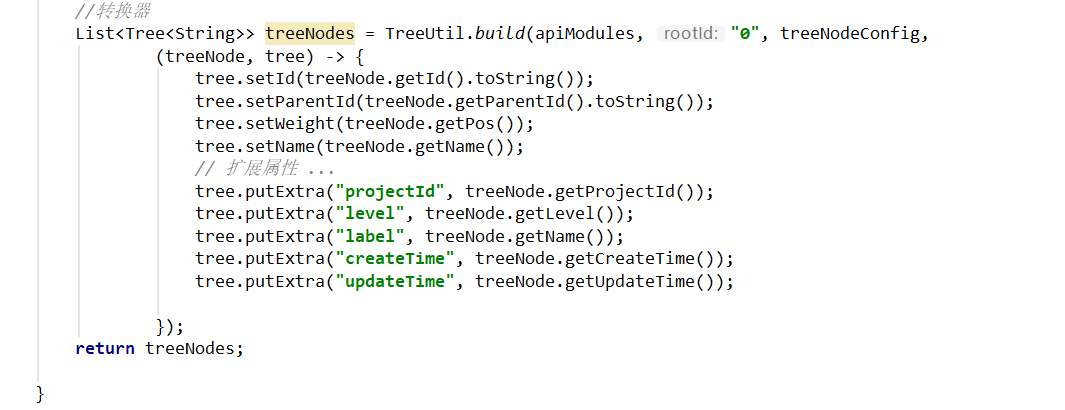springboot vue接口测试HutoolUtil TreeUtil处理树形结构
基于springboot+vue的测试平台开发
继续更新
上次完成了接口定义功能的前端页面,那么后端现在开始逐一实现对应的功能,首先就是提供模块列表接口,这个模块是支持子层级的,所以大概结构是这样:
[
{
id: 1,
label: '默认',
children: [
{
id: 4,
label: '二级子模块1',
children: [
{
id: 9,
label: '三级子模块1'
},
{
id: 10,
label: '三级子模块2'
}
]
}
]
},
{
id: 2,
label: '一级子模块2',
children: [
{
id: 5,
label: '二级子模块 1'
},
{
id: 6,
label: '二级子模块 2'
}
]
}
]通常来说,可以写递归代码来找出子层级的数据,然后再进行封装返回出来,比较麻烦。
后来发现 HutoolUtil 中有个工具类 TreeUtil 可以完成我需求,非常便捷,本次就使用它来实现。
下面来完成接口功能的开发。
一、引用 HutoolUtil
Hutool是一个小而全的Java工具类库,通过静态方法封装,降低相关API的学习成本,提高工作效率,使Java拥有函数式语言般的优雅,让Java语言也可以“甜甜的”。
Hutool中的工具方法来自每个用户的精雕细琢,它涵盖了Java开发底层代码中的方方面面,它既是大型项目开发中解决小问题的利器,也是小型项目中的效率担当;
Hutool是项目中“util”包友好的替代,它节省了开发人员对项目中公用类和公用工具方法的封装时间,使开发专注于业务,同时可以最大限度的避免封装不完善带来的bug。
要使用它直接添加依赖即可:
<!--hutool-->
<dependency>
<groupId>cn.hutool</groupId>
<artifactId>hutool-all</artifactId>
<version>5.7.12</version>
</dependency>官方文档:https://www.hutool.cn/docs/#/
内容很详细,不仅后面的树结构工具,像常用的集合类、JSON、日志、缓存、文件、线程和并发等等应有尽有。
二、建表
给模块建一张新表api_module:
CREATE TABLE `api_module` (
`id` bigint NOT NULL AUTO_INCREMENT COMMENT 'id',
`projectId` bigint NOT NULL COMMENT '该节点所属项目id',
`name` varchar(64) COLLATE utf8mb4_general_ci NOT NULL COMMENT '节点名称',
`parentId` varchar(50) COLLATE utf8mb4_general_ci DEFAULT NULL COMMENT '父节点id',
`level` int DEFAULT '1' COMMENT '节点层级',
`createTime` datetime NOT NULL DEFAULT '1900-01-01 00:00:00' COMMENT '创建时间',
`updateTime` datetime NOT NULL DEFAULT '1900-01-01 00:00:00' COMMENT '更新时间',
`pos` double DEFAULT NULL COMMENT '节点顺序位置',
PRIMARY KEY (`id`)
) ENGINE=InnoDB AUTO_INCREMENT=1 DEFAULT CHARSET=utf8mb4 COLLATE=utf8mb4_general_ci COMMENT='模块表';重要字段:
projectId:与项目进行关联
parentId:该节点的父节点,一级目录的父节点我会设置为 0 。
level:该节点对应层级,从 1 开始。
pos:表示该节点在父节点下的位置顺序。
三、后端接口实现
1. Controller 层
新建 ApiModuleController 类,添加一个处理器方法 getNodeByProjectId,通过项目 ID 查询出下面的所有模块。
package com.pingguo.bloomtest.controller;
import com.pingguo.bloomtest.common.Result;
import com.pingguo.bloomtest.service.ApiModuleService;
import org.springframework.beans.factory.annotation.Autowired;
import org.springframework.web.bind.annotation.*;
@RestController
@RequestMapping("module")
public class ApiModuleController {
@Autowired
ApiModuleService apiModuleService;
@GetMapping("/list/{projectId}")
public Result getNodeByProjectId(@PathVariable Long projectId) {
return Result.success(apiModuleService.getNodeTreeByProjectId(projectId));
}
}2. DAO层
dao 层自然也要有。
package com.pingguo.bloomtest.dao;
import com.baomidou.mybatisplus.core.mapper.BaseMapper;
import com.pingguo.bloomtest.pojo.ApiModule;
import org.springframework.stereotype.Repository;
@Repository
public interface ApiModuleDAO extends BaseMapper<ApiModule> {
}3. Service 层
实现 getNodeTreeByProjectId 方法。
public List<Tree<String>> getNodeTreeByProjectId(Long projectId) {
this.getDefaultNode(projectId);
// 根据 projectId 查询所有节点
QueryWrapper<ApiModule> wrapperApiModule = new QueryWrapper<>();
List<ApiModule> apiModules = apiModuleDAO.selectList(wrapperApiModule.eq("projectId", projectId));
// 配置
TreeNodeConfig treeNodeConfig = new TreeNodeConfig();
// 自定义属性名 ,即返回列表里对象的字段名
treeNodeConfig.setIdKey("id");
treeNodeConfig.setWeightKey("pos");
treeNodeConfig.setParentIdKey("parentId");
treeNodeConfig.setChildrenKey("children");
// 最大递归深度
// treeNodeConfig.setDeep(5);
treeNodeConfig.setNameKey("name");
//转换器
List<Tree<String>> treeNodes = TreeUtil.build(apiModules, "0", treeNodeConfig,
(treeNode, tree) -> {
tree.setId(treeNode.getId().toString());
tree.setParentId(treeNode.getParentId().toString());
tree.setWeight(treeNode.getPos());
tree.setName(treeNode.getName());
// 扩展属性 ...
tree.putExtra("projectId", treeNode.getProjectId());
tree.putExtra("level", treeNode.getLevel());
tree.putExtra("label", treeNode.getName());
tree.putExtra("createTime", treeNode.getCreateTime());
tree.putExtra("updateTime", treeNode.getUpdateTime());
});
return treeNodes;
}这里开头有个方法 getDefaultNode,在这里面会判断当前项目下是否有默认模块,没有则添加默认模块。
private void getDefaultNode(Long projectId) {
QueryWrapper<ApiModule> wrapperApiModule = new QueryWrapper<>();
wrapperApiModule.eq("projectId", projectId)
.eq("pos", 1.0);
// 判断当前项目下是否有默认模块,没有则添加默认模块
if (apiModuleDAO.selectCount(wrapperApiModule) == 0) {
ApiModule apiModule = new ApiModule();
apiModule.setName("默认");
apiModule.setPos(1.0);
apiModule.setLevel(1);
apiModule.setParentId(0L);
apiModule.setCreateTime(new Date());
apiModule.setUpdateTime(new Date());
apiModule.setProjectId(projectId);
apiModuleDAO.insert(apiModule);
}
}然后通过 项目id 把项目下所有的数据查询出来:

接下来使用 TreeUtil 来完成树结构处理。
首先,创建一个配置类 TreeNodeConfig 对象,在这个对象里设置属性,对应的就是返回出来的字段名。

还可以设置最大递归深度,也可以不设。我测试之后就注释掉了,先不加限制。
最后就是构建树结构 treeNodes,完成处理后返回给 controller 层。

因为我要返回的还有其他的字段,可以使用tree.putExtra来添加要返回的其他字段,比如:
tree.putExtra("projectId", treeNode.getProjectId());第一个参数是定义的字段名称,第二个参数就是使用这个结点的 get 方法获取对应的属性值。
最后返回到上层的是List<Tree<String>>类型,可以直接塞到统一结果里去返回。

四、测试一下
1. 测试结构数据
测试一下接口,先手动网表里插入了对应结构的数据。

请求接口,传入 projectId 为 3。
{
"code": 20000,
"message": "成功",
"data": [
{
"id": "9",
"parentId": "0",
"pos": 1.0,
"name": "默认",
"projectId": 3,
"level": 1,
"label": "默认",
"createTime": "2021-09-29 10:50:00",
"updateTime": "2021-09-29 10:50:00",
"children": [
{
"id": "14",
"parentId": "9",
"pos": 1.0,
"name": "默认-2",
"projectId": 3,
"level": 2,
"label": "默认-2",
"createTime": "1900-01-01 08:00:00",
"updateTime": "1900-01-01 08:00:00"
},
{
"id": "10",
"parentId": "9",
"pos": 1.0,
"name": "默认-1",
"projectId": 3,
"level": 2,
"label": "默认-1",
"createTime": "2021-10-01 08:00:00",
"updateTime": "1900-01-01 08:00:00",
"children": [
{
"id": "11",
"parentId": "10",
"pos": 1.0,
"name": "默认-1-1",
"projectId": 3,
"level": 3,
"label": "默认-1-1",
"createTime": "1900-01-01 08:00:00",
"updateTime": "1900-01-01 08:00:00",
"children": [
{
"id": "12",
"parentId": "11",
"pos": 1.0,
"name": "默认-1-1-1",
"projectId": 3,
"level": 4,
"label": "默认-1-1-1",
"createTime": "1900-01-01 08:00:00",
"updateTime": "1900-01-01 08:00:00",
"children": [
{
"id": "13",
"parentId": "12",
"pos": 1.0,
"name": "默认-1-1-1-1",
"projectId": 3,
"level": 5,
"label": "默认-1-1-1-1",
"createTime": "1900-01-01 08:00:00",
"updateTime": "1900-01-01 08:00:00"
}
]
}
]
}
]
}
]
}
]
}结果正确。
2. 测试新增默认
传入一个 projectId 为 4 ,localhost:8080/bloomtest/module/list/4:
{
"code": 20000,
"message": "成功",
"data": [
{
"id": "15",
"parentId": "0",
"pos": 1.0,
"name": "默认",
"projectId": 4,
"level": 1,
"label": "默认",
"createTime": "2021-10-01 12:25:54",
"updateTime": "2021-10-01 12:25:54"
}
]
}返回正确。

落库正常。
以上就是springboot vue接口测试HutoolUtil TreeUtil处理树形结构的详细内容,更多关于HutoolUtil TreeUtil处理树形结构的资料请关注编程学习网其它相关文章!
